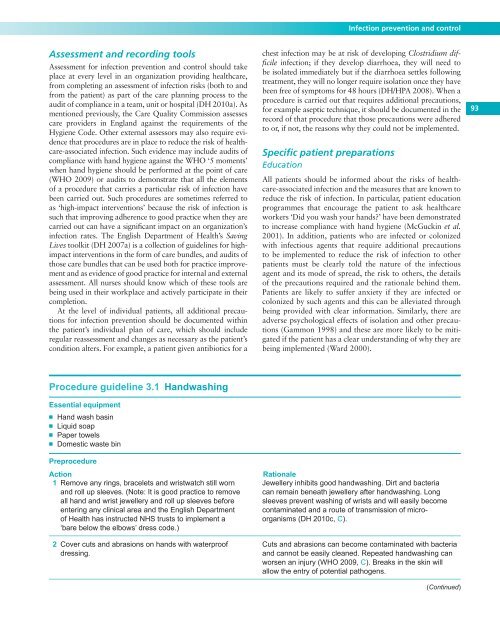Infection prevention and control - Royal Marsden Manual of Clinical ...
Infection prevention and control - Royal Marsden Manual of Clinical ...
Infection prevention and control - Royal Marsden Manual of Clinical ...
Create successful ePaper yourself
Turn your PDF publications into a flip-book with our unique Google optimized e-Paper software.
Assessment <strong>and</strong> recording tools<br />
Assessment for infection <strong>prevention</strong> <strong>and</strong> <strong>control</strong> should take<br />
place at every level in an organization providing healthcare,<br />
from completing an assessment <strong>of</strong> infection risks (both to <strong>and</strong><br />
from the patient) as part <strong>of</strong> the care planning process to the<br />
audit <strong>of</strong> compliance in a team, unit or hospital ( DH 2010a ). As<br />
mentioned previously, the Care Quality Commission assesses<br />
care providers in Engl<strong>and</strong> against the requirements <strong>of</strong> the<br />
Hygiene Code. Other external assessors may also require evidence<br />
that procedures are in place to reduce the risk <strong>of</strong> healthcare-associated<br />
infection. Such evidence may include audits <strong>of</strong><br />
compliance with h<strong>and</strong> hygiene against the WHO ‘5 moments’<br />
when h<strong>and</strong> hygiene should be performed at the point <strong>of</strong> care<br />
( WHO 2009 ) or audits to demonstrate that all the elements<br />
<strong>of</strong> a procedure that carries a particular risk <strong>of</strong> infection have<br />
been carried out. Such procedures are sometimes referred to<br />
as ‘high-impact interventions’ because the risk <strong>of</strong> infection is<br />
such that improving adherence to good practice when they are<br />
carried out can have a signifi cant impact on an organization’s<br />
infection rates. The English Department <strong>of</strong> Health’s Saving<br />
Lives toolkit ( DH 2007a ) is a collection <strong>of</strong> guidelines for highimpact<br />
interventions in the form <strong>of</strong> care bundles, <strong>and</strong> audits <strong>of</strong><br />
those care bundles that can be used both for practice improvement<br />
<strong>and</strong> as evidence <strong>of</strong> good practice for internal <strong>and</strong> external<br />
assessment. All nurses should know which <strong>of</strong> these tools are<br />
being used in their workplace <strong>and</strong> actively participate in their<br />
completion.<br />
At the level <strong>of</strong> individual patients, all additional precautions<br />
for infection <strong>prevention</strong> should be documented within<br />
the patient’s individual plan <strong>of</strong> care, which should include<br />
regular reassessment <strong>and</strong> changes as necessary as the patient’s<br />
condition alters. For example, a patient given antibiotics for a<br />
Procedure guideline 3.1 H<strong>and</strong>washing<br />
Essential equipment<br />
■ H<strong>and</strong> wash basin<br />
■ Liquid soap<br />
■ Paper towels<br />
■ Domestic waste bin<br />
Preprocedure<br />
Action Rationale<br />
1 Remove any rings, bracelets <strong>and</strong> wristwatch still worn<br />
<strong>and</strong> roll up sleeves. (Note: It is good practice to remove<br />
all h<strong>and</strong> <strong>and</strong> wrist jewellery <strong>and</strong> roll up sleeves before<br />
entering any clinical area <strong>and</strong> the English Department<br />
<strong>of</strong> Health has instructed NHS trusts to implement a<br />
‘bare below the elbows’ dress code.)<br />
2 Cover cuts <strong>and</strong> abrasions on h<strong>and</strong>s with waterpro<strong>of</strong><br />
dressing.<br />
<strong>Infection</strong> <strong>prevention</strong> <strong>and</strong> <strong>control</strong><br />
chest infection may be at risk <strong>of</strong> developing Clostridium diffi<br />
cile infection; if they develop diarrhoea, they will need to<br />
be isolated immediately but if the diarrhoea settles following<br />
treatment, they will no longer require isolation once they have<br />
been free <strong>of</strong> symptoms for 48 hours ( DH/HPA 2008 ). When a<br />
procedure is carried out that requires additional precautions,<br />
for example aseptic technique, it should be documented in the<br />
record <strong>of</strong> that procedure that those precautions were adhered<br />
to or, if not, the reasons why they could not be implemented.<br />
Specifi c patient preparations<br />
Education<br />
All patients should be informed about the risks <strong>of</strong> healthcare-associated<br />
infection <strong>and</strong> the measures that are known to<br />
reduce the risk <strong>of</strong> infection. In particular, patient education<br />
programmes that encourage the patient to ask healthcare<br />
workers ‘Did you wash your h<strong>and</strong>s?’ have been demonstrated<br />
to increase compliance with h<strong>and</strong> hygiene ( McGuckin et al.<br />
2001 ). In addition, patients who are infected or colonized<br />
with infectious agents that require additional precautions<br />
to be implemented to reduce the risk <strong>of</strong> infection to other<br />
patients must be clearly told the nature <strong>of</strong> the infectious<br />
agent <strong>and</strong> its mode <strong>of</strong> spread, the risk to others, the details<br />
<strong>of</strong> the precautions required <strong>and</strong> the rationale behind them.<br />
Patients are likely to suffer anxiety if they are infected or<br />
colonized by such agents <strong>and</strong> this can be alleviated through<br />
being provided with clear information. Similarly, there are<br />
adverse psychological effects <strong>of</strong> isolation <strong>and</strong> other precautions<br />
( Gammon 1998 ) <strong>and</strong> these are more likely to be mitigated<br />
if the patient has a clear underst<strong>and</strong>ing <strong>of</strong> why they are<br />
being implemented ( Ward 2000 ).<br />
Jewellery inhibits good h<strong>and</strong>washing. Dirt <strong>and</strong> bacteria<br />
can remain beneath jewellery after h<strong>and</strong>washing. Long<br />
sleeves prevent washing <strong>of</strong> wrists <strong>and</strong> will easily become<br />
contaminated <strong>and</strong> a route <strong>of</strong> transmission <strong>of</strong> microorganisms<br />
( DH 2010c, C ).<br />
Cuts <strong>and</strong> abrasions can become contaminated with bacteria<br />
<strong>and</strong> cannot be easily cleaned. Repeated h<strong>and</strong>washing can<br />
worsen an injury ( WHO 2009 , C ). Breaks in the skin will<br />
allow the entry <strong>of</strong> potential pathogens.<br />
(Continued)<br />
93


